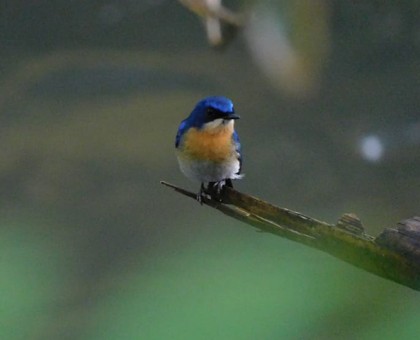18 Nov, 2024
A RARE ENCOUNTER WITH THE ELUSIVE BORNEAN ANGLEHEAD LIZARD
BIODIVERSITY
Recently, our Post-Release Monitoring (PRM) team conducted a phenology patrol along several lengthy transects in the southern part of Kehje Sewen Forest. Equipped with rubber boots, our PRM team braved the rain, stepping cautiously on the slippery, damp ground. The rain jackets they wore barely managed to keep out the heavy downpour that day.
Read also: THE SUSPECTED CHICKEN THIEF IN THE JUNGLE
Kehje Sewen Forest suddenly felt colder than usual. Almost no leaf or branch was spared from the rain, which created a serene, almost magical atmosphere. In this quiet, rain-soaked landscape, our team spotted an unexpected and awe-inspiring creature—the Bornean anglehead lizard (Gonocephalus borneensis).
The Bornean anglehead lizard is a fascinating species, known for its bright green scales and distinctive head shape that gives it a “crowned” appearance. Male lizards are brown, while females are lighter in colour. It's crest resembles a comb extending from the head down the neck to the base of the tail, and its tail length exceeds twice the body length.
Read also: A PERFECT PAIR OF HORNBILLS
This lizard possesses an impressive ability to camouflage. Our PRM team almost missed its presence due to its perfect blending ability. Moreover, it’s often hard to find, as it prefers to hide among thick vegetation. This lizard is usually found in lowland forests with canopy coverage between 75%-80% and far from rivers. However, the rainy weather may have brought it closer to the ground, allowing our team a rare and precious sighting of this elusive species.
Read also: THE EXTRAORDINARY BUT DEADLY SUMATRA PIT VIPER
As our team observed, the lizard appeared undisturbed by the rain. This encounter served as a reminder of the delicate balance within the Kehje Sewen Forest ecosystem. After thoroughly documenting this unique species, our team continued the phenology patrol with a renewed sense of wonder for the biodiversity around them. Although the rain added more challenges to the day’s patrol, our team felt even more motivated to remain committed to protecting this rich yet fragile habitat.
Text by: Biodiversity-PRM Team, PT. RHOI at Kehje Sewen Forest, East Kalimantan




